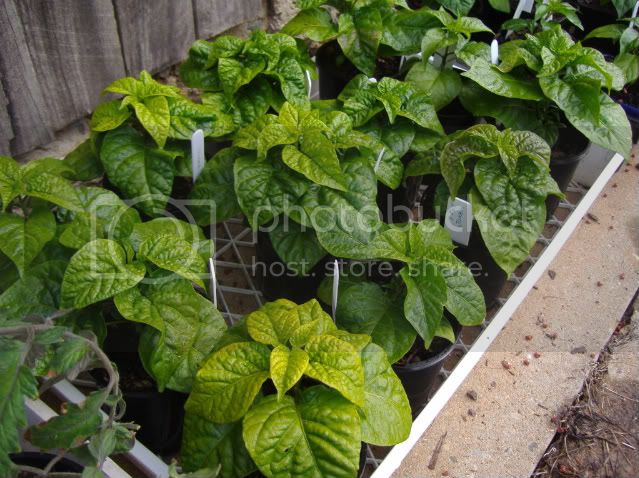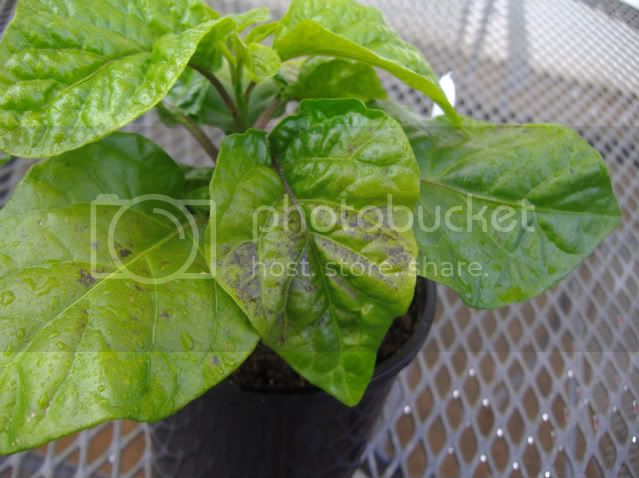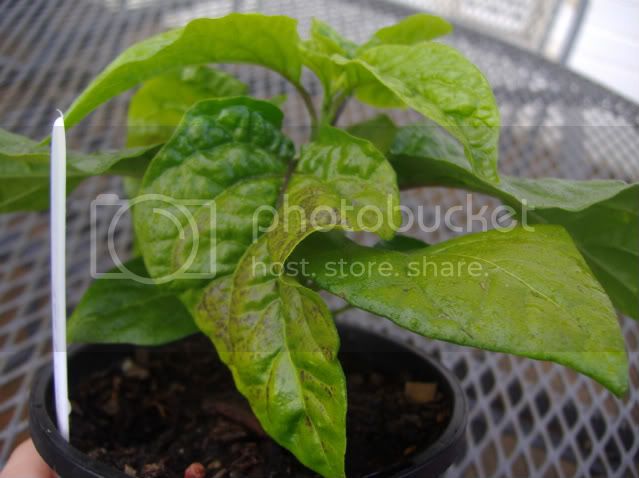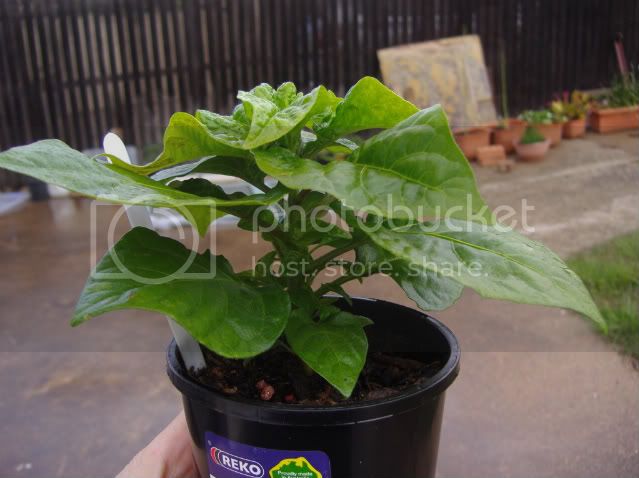Hi Guys.
As I said in my intro - I have been a chilli lover for years, and started growing for the first time last year. But much more seriously this year.
It has been a great journey. I cant believe how much there is to learn. And all of it has been awesome - I've been like an information sponge lately... trying to absorb all the stuff I can. The other thing is I can't believe how much pleasure and satisfaction is to be had with it all. My green thumb is swollen right now.
Along the way I have encountered a few things that I had to deal with - but by asking questions and researching I have generally found an answer or solution - till now!
I'd like to share my photos with you... and then hope that you guys may be able to help me with some issues I have got - that I cant solve or find solutions for.
First off - I started my 'garden' in propagation trays, that were on a heat mat. I got good results with near 100% germination of all my seeds. These included lots of exotics from India, Bangladesh and Trinidad. I'm so looking forward to these. I cant wait!! Scorpions, 7 pods, Nagas, Jolokias, Habs... this is going to a fun ride!
After about 6 weeks - being new to this I didn't really know what to expect at this stage - but they looked good to me - good growth and strong plants. The only thing that concerned me is the slight yellowing in the tops of the plants. I checked PH and it was 6.
This photo is where I'm at now. As you can see, they are all fairly compact with lots of foliage... but they are showing some interesting (concerning?) features - some yellowing, some with very twisted leaves, some deep puckering, brown staining...

I am particularly concerned with the next one. It is the 7 Pod - it is showing lots of brown and dark brown 'staining' on the leaves. This is the worst example of it.. but some of the others are also showing the same thing. And also the heavily twisted leaves.


The following is a Red Savina. I've added this photo to give an example of the kind of growth I'm getting. The plants are quite compact, with large leaves and growth on what is a shortish plant (4 inches tall or so). It is in a 100mm / 4 inch pot.

-----
So, some information that may assist you in giving your opinions:
* Early on, while in the propagation box, I did have to adjust PH. The plants were yellowing, so I checked the PH and it was 8. A quick adjustment to PH6 and the plants were looking nice and green in no time.
* All waterings since then have maintained PH6. A check of the soil/water also confirm that the PH in the pots is ~6.
* once transplanted into the 100mm pots I alternated waterings between using just straight water and then 1/2 strength (10ml per 5 litres) Dutch Fest "Bloom" the next time... and so on, back and forth.
* the plants were raised under a 110w CFL till they were about 3 inches tall, and then moved under a 600w HPS (GE LucaGrow). I started out with about 80cm between the plants and light... and then moved as close as 45cm for the last 2 weeks. Fans were used to circulate air and keep plants cool. Ambient air temp was 21 degrees Celsius (70f) and soil temps about 18 C (65 F).
* I did notice the Jalapeno and Capsicums had some very minor aphid activity... but I took care of that immediately with organic spray. No pests have been detected on the other varieties.
* I did apply one very small amount of fertiliser (with trace elements) to the top surface of soil in each pot. The amount I added was just a small "pinch" between my thumb and forefinger. I understand now that chillis probably dont like being fertilised.. but I did it before I knew that.
* Since being transplanted, I did one watering with "MaxiCrop" seaweed/food about 2 weeks ago.
* Hmmm... I dont know what else to say.
---
So, what do you guys reckon?
Advice?
Suggestions?
Feedback?
I'm particularly curious if you think the plants are ok. Not just the spotted and yellow ones... but all of them.
Do you think they are to bushy and compact? Should they be taller and less compact?
Are the spotted ones doomed?
Thanks for reading everyone. If you got this far I applaud you. Well done! I owe you.
As I said in my intro - I have been a chilli lover for years, and started growing for the first time last year. But much more seriously this year.
It has been a great journey. I cant believe how much there is to learn. And all of it has been awesome - I've been like an information sponge lately... trying to absorb all the stuff I can. The other thing is I can't believe how much pleasure and satisfaction is to be had with it all. My green thumb is swollen right now.
Along the way I have encountered a few things that I had to deal with - but by asking questions and researching I have generally found an answer or solution - till now!
I'd like to share my photos with you... and then hope that you guys may be able to help me with some issues I have got - that I cant solve or find solutions for.
First off - I started my 'garden' in propagation trays, that were on a heat mat. I got good results with near 100% germination of all my seeds. These included lots of exotics from India, Bangladesh and Trinidad. I'm so looking forward to these. I cant wait!! Scorpions, 7 pods, Nagas, Jolokias, Habs... this is going to a fun ride!
After about 6 weeks - being new to this I didn't really know what to expect at this stage - but they looked good to me - good growth and strong plants. The only thing that concerned me is the slight yellowing in the tops of the plants. I checked PH and it was 6.
This photo is where I'm at now. As you can see, they are all fairly compact with lots of foliage... but they are showing some interesting (concerning?) features - some yellowing, some with very twisted leaves, some deep puckering, brown staining...

I am particularly concerned with the next one. It is the 7 Pod - it is showing lots of brown and dark brown 'staining' on the leaves. This is the worst example of it.. but some of the others are also showing the same thing. And also the heavily twisted leaves.


The following is a Red Savina. I've added this photo to give an example of the kind of growth I'm getting. The plants are quite compact, with large leaves and growth on what is a shortish plant (4 inches tall or so). It is in a 100mm / 4 inch pot.

-----
So, some information that may assist you in giving your opinions:
* Early on, while in the propagation box, I did have to adjust PH. The plants were yellowing, so I checked the PH and it was 8. A quick adjustment to PH6 and the plants were looking nice and green in no time.
* All waterings since then have maintained PH6. A check of the soil/water also confirm that the PH in the pots is ~6.
* once transplanted into the 100mm pots I alternated waterings between using just straight water and then 1/2 strength (10ml per 5 litres) Dutch Fest "Bloom" the next time... and so on, back and forth.
* the plants were raised under a 110w CFL till they were about 3 inches tall, and then moved under a 600w HPS (GE LucaGrow). I started out with about 80cm between the plants and light... and then moved as close as 45cm for the last 2 weeks. Fans were used to circulate air and keep plants cool. Ambient air temp was 21 degrees Celsius (70f) and soil temps about 18 C (65 F).
* I did notice the Jalapeno and Capsicums had some very minor aphid activity... but I took care of that immediately with organic spray. No pests have been detected on the other varieties.
* I did apply one very small amount of fertiliser (with trace elements) to the top surface of soil in each pot. The amount I added was just a small "pinch" between my thumb and forefinger. I understand now that chillis probably dont like being fertilised.. but I did it before I knew that.
* Since being transplanted, I did one watering with "MaxiCrop" seaweed/food about 2 weeks ago.
* Hmmm... I dont know what else to say.
---
So, what do you guys reckon?
Advice?
Suggestions?
Feedback?
I'm particularly curious if you think the plants are ok. Not just the spotted and yellow ones... but all of them.
Do you think they are to bushy and compact? Should they be taller and less compact?
Are the spotted ones doomed?
Thanks for reading everyone. If you got this far I applaud you. Well done! I owe you.
